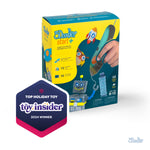STEM: Doodle Maze
In this activity, students will work in pairs to design their own 3Doodler Marble Maze using an online interactive maze tool. Students will incorporate elements of maze design including diversions into their mazes and then play them using a tiny tin foil ball as the marble.

KnowledgeStudents havehad practice with the 3Doodler.
had practice solving pencil and paper mazes.
had practice with the 3Doodler.
had practice solving pencil and paper mazes.
ObjectivesStudents willuse an Online Maze Generator to design their mazes.
use a 3Doodler to create a 3D maze.
recognize maze features: alleys, loops, spirals, dead ends.
apply what they know about maze features to the design of their group's maze.
use an Online Maze Generator to design their mazes.
use a 3Doodler to create a 3D maze.
recognize maze features: alleys, loops, spirals, dead ends.
apply what they know about maze features to the design of their group's maze.
MaterialsStudents will need3Doodler (1 per pair)
4" x 4" precut squares of foam board (1 per pair)
computer or tablet (1 per pair)
printer (1 for class)
1" square of tin foil (1 per pair)
3Doodler (1 per pair)
4" x 4" precut squares of foam board (1 per pair)
computer or tablet (1 per pair)
printer (1 for class)
1" square of tin foil (1 per pair)
Lesson PlanInstructions
Step 1 - PREPARATIONPrepare a large sheet of bulletin board paper with a 20 x 20 grid, ensuring that each square is 2" x 2". Trace over your grid lines with a marker.
Step 2Whole group: Discuss some of the mazes students have worked on in the past. What do they all have in common?
*Possible responses: Mazes are puzzles and require problem-solving.
Step 3Using a large sheet of bulletin board paper, demonstrate how to create a maze together. Ask for two volunteers. Have the START student stand on one side of the grid and the END student stand on the other. Instruct the 2 students to draw a zigzag line through the grid boxes that meet in the middle. This will be the direct path. The line represents the alley or pathway.
*See Appendix
Step 4Demonstrate how to add "diversions" to the maze to divert the player trying to solve the maze. Include loops, spirals and dead ends.
*See Appendix
Step 5Share the goal: Students will work with a partner to design a 3D marble maze using an Online Maze Generator. Their maze must contain a START and END point, a direct path and diversions.
Step 6Project your computer or tablet screen on the board and demonstrate how to use the Online Maze Generator.
Step 7Create a direct path first, then add the diversions. Try to cover the whole grid with alleys.
Step 8Instruct how to take a screenshot of a completed online maze. Save it, size it 4" x 4", print it and glue the printed maze to foam board in order to create a solid base.
Step 9Model how to doodle in the walls of your maze, stopping to pinch the plastic while it's still warm to create height.
Step 10Create a tiny ball for your maze using tin foil. *Optional: Cover your maze with clear acetate or transparency.
Step 11Hand out computers for students to begin online maze design. Check students' work. Remind students to take, save and print a screenshot of their maze. *They will need help with sizing.
Step 12Instruct students to glue their paper maze onto 4" x 4" foam board. Hand out 3Doodlers to begin doodling in maze walls.
Prepare a large sheet of bulletin board paper with a 20 x 20 grid, ensuring that each square is 2" x 2". Trace over your grid lines with a marker.
Whole group: Discuss some of the mazes students have worked on in the past. What do they all have in common?
*Possible responses: Mazes are puzzles and require problem-solving.
Using a large sheet of bulletin board paper, demonstrate how to create a maze together. Ask for two volunteers. Have the START student stand on one side of the grid and the END student stand on the other. Instruct the 2 students to draw a zigzag line through the grid boxes that meet in the middle. This will be the direct path. The line represents the alley or pathway.
*See Appendix
Demonstrate how to add "diversions" to the maze to divert the player trying to solve the maze. Include loops, spirals and dead ends.
*See Appendix
Share the goal: Students will work with a partner to design a 3D marble maze using an Online Maze Generator. Their maze must contain a START and END point, a direct path and diversions.
Project your computer or tablet screen on the board and demonstrate how to use the Online Maze Generator.
Create a direct path first, then add the diversions. Try to cover the whole grid with alleys.
Instruct how to take a screenshot of a completed online maze. Save it, size it 4" x 4", print it and glue the printed maze to foam board in order to create a solid base.
Model how to doodle in the walls of your maze, stopping to pinch the plastic while it's still warm to create height.
Create a tiny ball for your maze using tin foil. *Optional: Cover your maze with clear acetate or transparency.
Hand out computers for students to begin online maze design. Check students' work. Remind students to take, save and print a screenshot of their maze. *They will need help with sizing.
Instruct students to glue their paper maze onto 4" x 4" foam board. Hand out 3Doodlers to begin doodling in maze walls.
Wrap Up
Discuss what was challenging. How did they overcome obstacles? How could their designs be improved?
Assessment
Possible Extensions
Resources
Vocabulary
alleys - a passage, as through a continuous row of houses, permitting access from the street to backyards, garages, etc.
collaboration - to work jointly with others or together especially in an intellectual endeavor.
dead ends - something, as a street or water pipe, that has no exit.
design - to prepare the preliminary sketch or the plans (for a work to be executed), especially to plan the form and structure of an object, building, bridge, etc...
drafting - the process of creating a first or preliminary form of any writing, subject to revision, copying, etc.
drawing - the art or technique of representing an object or outlining a figure, plan, or sketch by means of lines.
geometry - a branch of mathematics that deals with the measurement, properties, and relationships of points, lines, angles, surfaces, and solids; broadly : the study of properties of given elements that remain invariant under specified transformations.
loops - a circular area at the end of a trolley line, railroad line, etc., where cars turn around.
maze - a confusing network of intercommunicating paths or passages; labyrinth.
problem-solving - the process or act of finding a solution to a problem.
shapes - the quality of a distinct object or body in having an external surface or outline of specific form or figure.
spirals - a plane curve generated by a point moving around a fixed point while constantly receding from or approaching it.
Educational Standards
Engage effectively in a range of collaborative discussions (one-on- one, in
groups, and teacher-led) with diverse partners on grade 4 topics and texts, building on others' ideas and expressing their own clearly.
Students will listen to their partner throughout the process, sharing ideas and offering feedback. Students will participate in a collaborative discussion at the end of this project to reflect on the process and outcome.
Pose and respond to specific questions to clarify or follow up on information, and make comments that contribute to the discussion and link to the remarks of others.
Students will respond to questions posed by the teacher, peers or partner during the instruction, the design process, and the modeling and reflection portions of this project.
Report on a topic or text, tell a story, or recount an experience in an
organized manner, using appropriate facts and relevant, descriptive details to support main ideas or themes; speak clearly at an understandable pace.
Students will work with a partner to recount their experience designing and modeling their 3D maze during the reflection portion of this project.
Decompose (break down) a larger problem into smaller sub-problems with teacher guidance or independently.
Students will break down the maze design process into instruction, practice, design, and modeling.
Use technology to seek feedback that informs and improves their practice and to demonstrate their learning in a variety of ways.
Students will use the 3Doodler to create a 3D marble maze.
Create original works or responsibly repurpose or remix digital resources into new creations.
Students will use a 3Doodler to doodle a 3D marble maze.
Use collaborative technologies to work with others, including peers, experts or community members, to examine issues and problems from multiple viewpoints.
Students will seek feedback from a partner during all stages of the design and reflection process.





